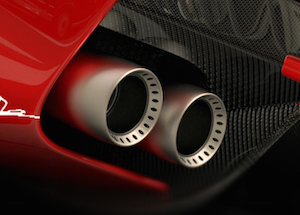Cold Start Engine Emissions
John Simpson | September 07, 2016Automakers wishing to reduce the emissions that their gasoline-powered vehicles generate should focus on design changes targeting pollutants that are emitted immediately after a cold start, new research suggests.
To find out what vehicles on the road are currently emitting, scientists from the University of California, Berkeley; Carnegie Mellon University; the University of California, San Diego; and the Massachusetts Institute of Technology rented 25 gasoline-powered cars, including two hybrids, from residents in the Los Angeles area. The vehicles ranged in age from 2 to 20 years.
 The concentrated release of emissions very early in a car’s operation occurs because its catalytic converter hasn’t had a chance to warm up. Image credit: Pixabay.They took the cars to the Haagen-Smit Laboratory and drove them on a giant treadmill. Using a proton-transfer reaction mass spectrometer, the researchers were able to measure a wide range of compounds coming out of tailpipes—including fuel components such as benzene, toluene and xylenes, as well as incomplete-combustion products such as acetaldehyde, formaldehyde and acetonitrile.
The concentrated release of emissions very early in a car’s operation occurs because its catalytic converter hasn’t had a chance to warm up. Image credit: Pixabay.They took the cars to the Haagen-Smit Laboratory and drove them on a giant treadmill. Using a proton-transfer reaction mass spectrometer, the researchers were able to measure a wide range of compounds coming out of tailpipes—including fuel components such as benzene, toluene and xylenes, as well as incomplete-combustion products such as acetaldehyde, formaldehyde and acetonitrile.
The researchers found that almost all emissions in properly functioning new vehicles came out immediately after starting the cars when their engines were cold. Once the new cars warmed up, they had to be driven 100 to 300 miles to match the levels that came out in the first 30 seconds after the engine was turned on. Even malfunctioning and older cars had to travel 50 to 100 miles to release the same amount of emissions as they did within the first minute of a cold start, the researchers found.
This concentrated release very early in a car’s operation occurs because its catalytic converter, which breaks down VOCs, hasn’t had a chance to warm up yet, says Greg Drozd, postdoctoral research scientist at UC Berkeley. The faster it can heat up, the lower the emissions could be, he adds.
Despite the results, Drozd nonetheless notes how effective emission controls have become for organic gases on newer cars. Vehicles less than two years old, he says, emitted as little as 1% of the total amount of organic gases that 20-year-old vehicles emit.





Vehicles working plays an important in engine production. The more people buy the more it goes popular. The https://www.rushmypa